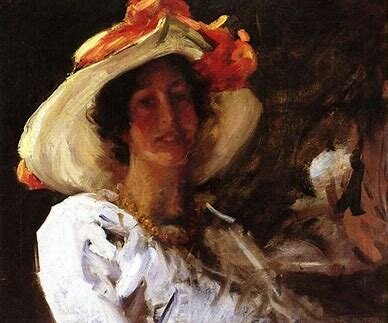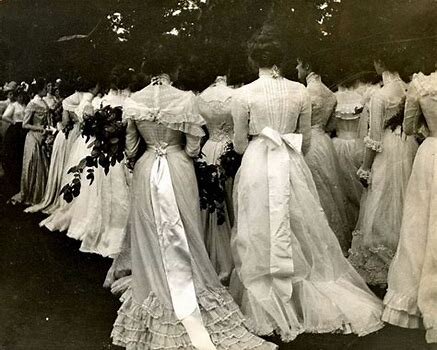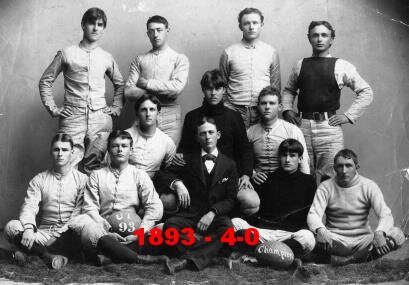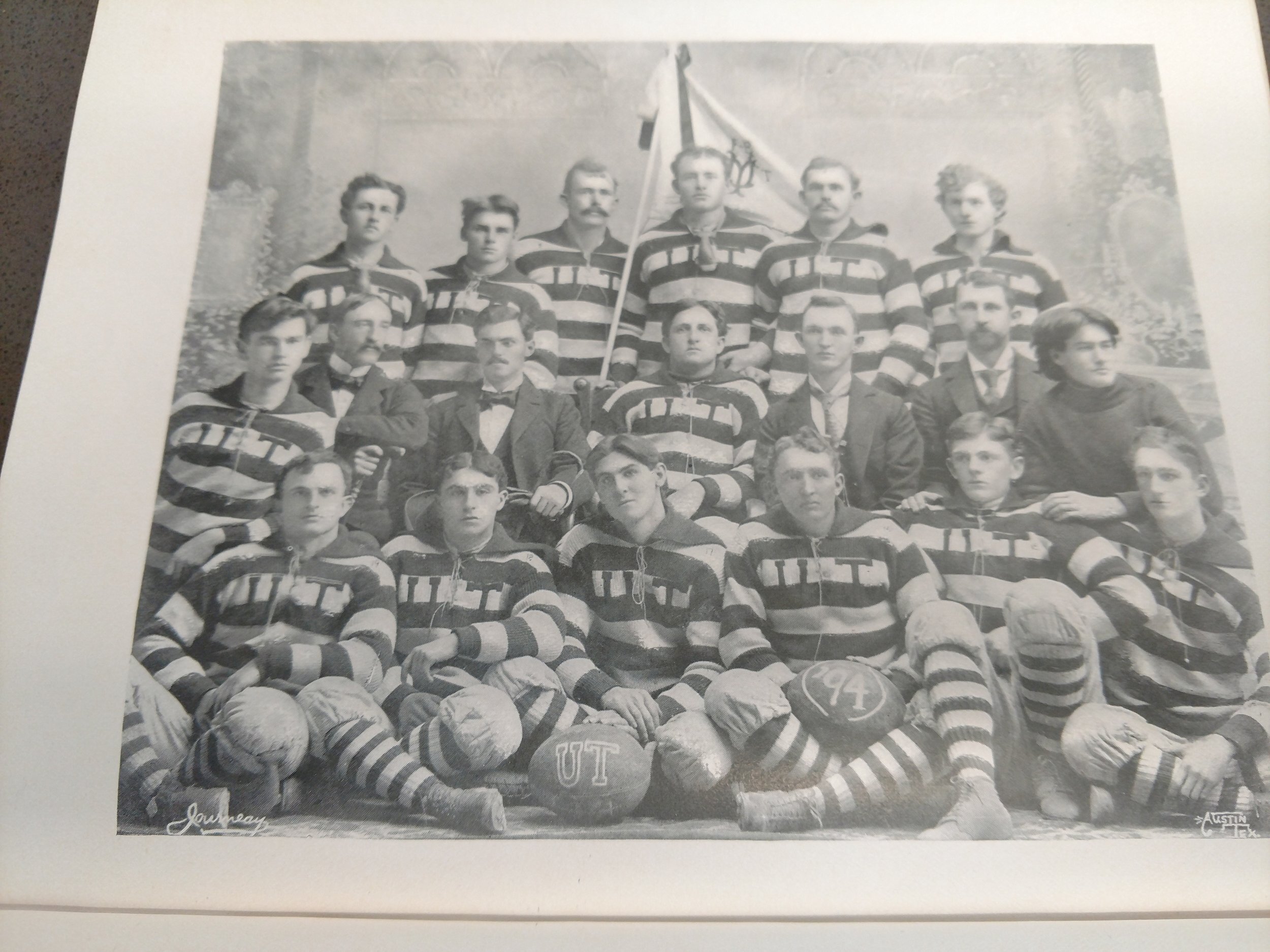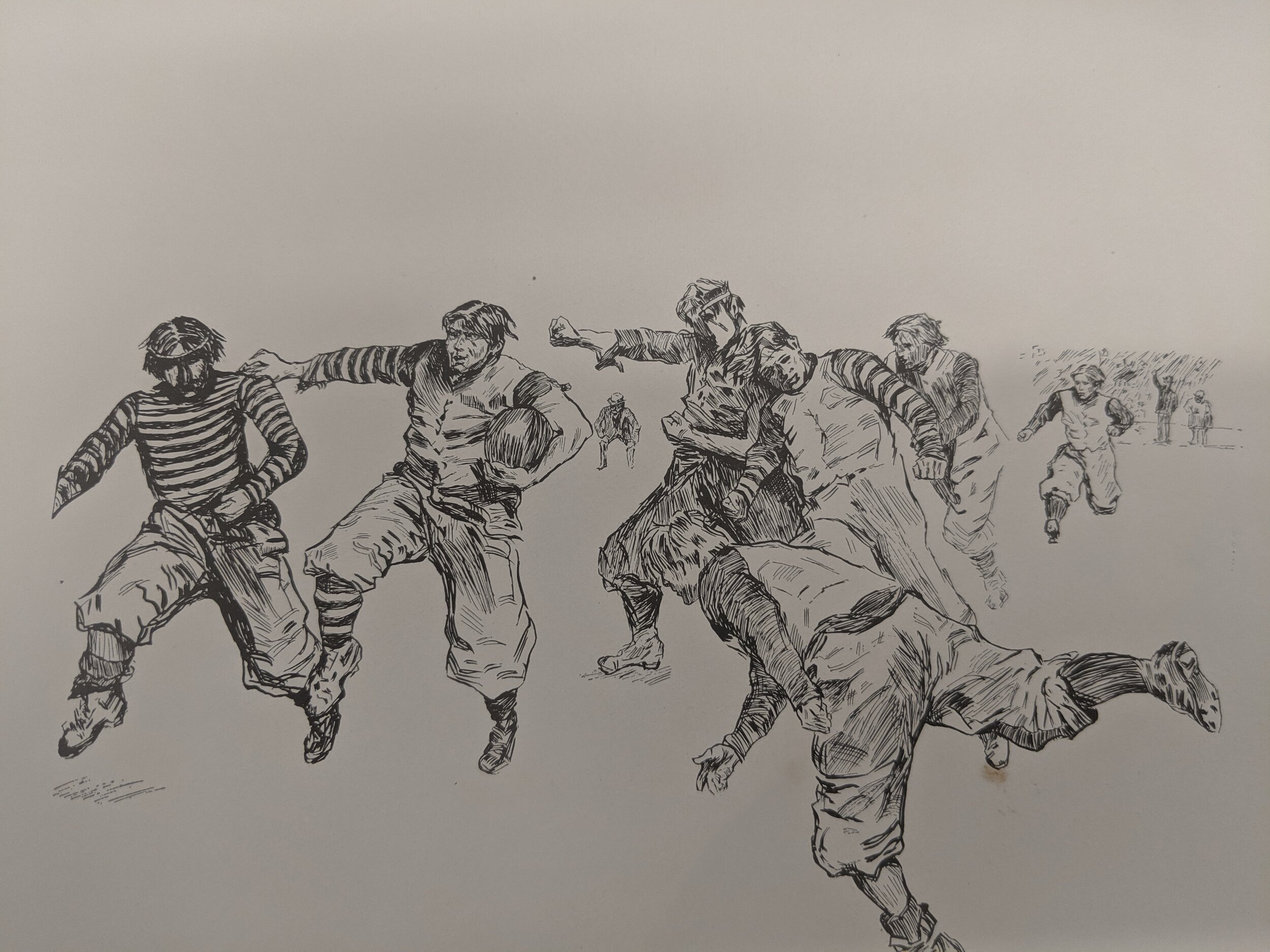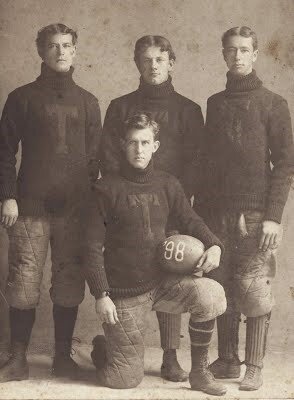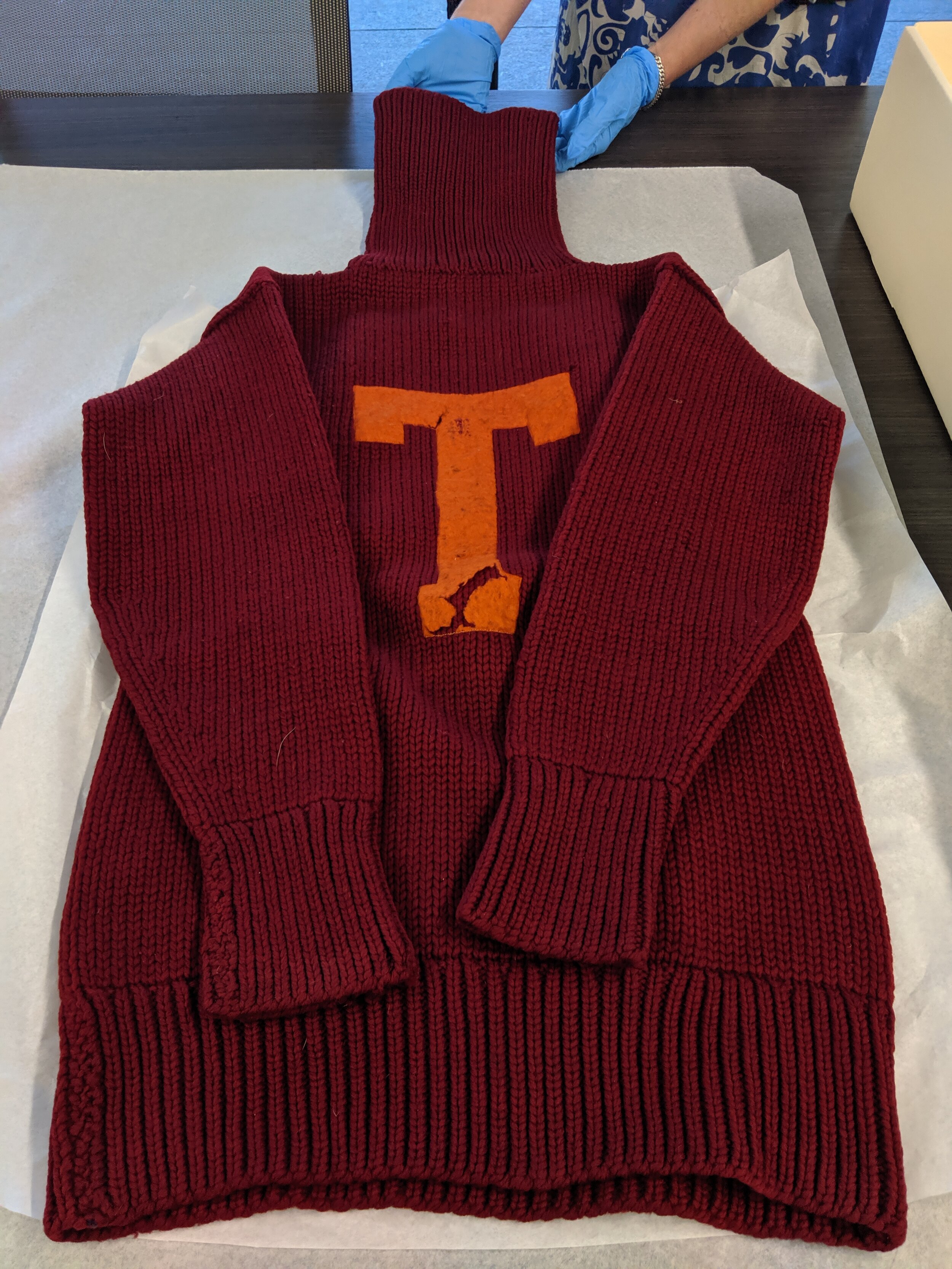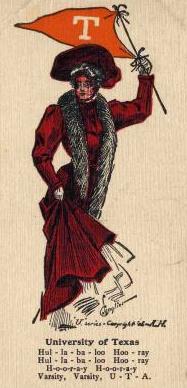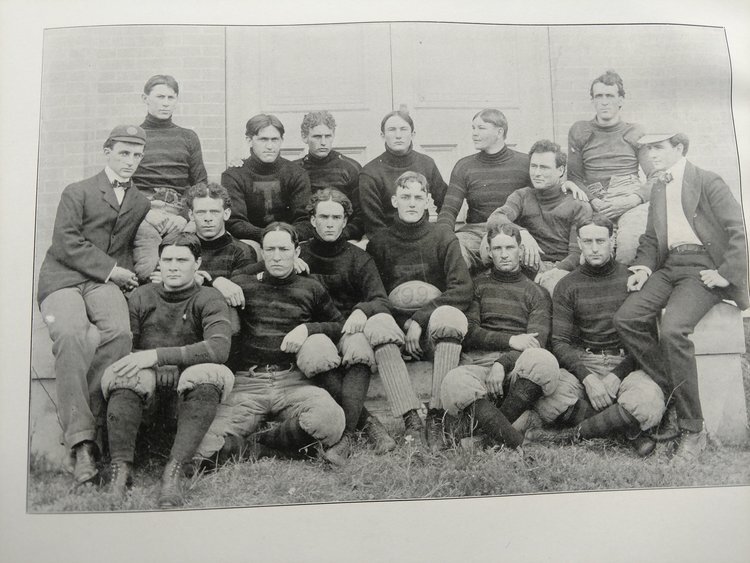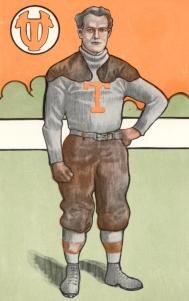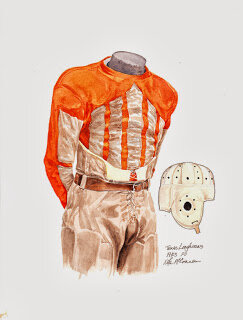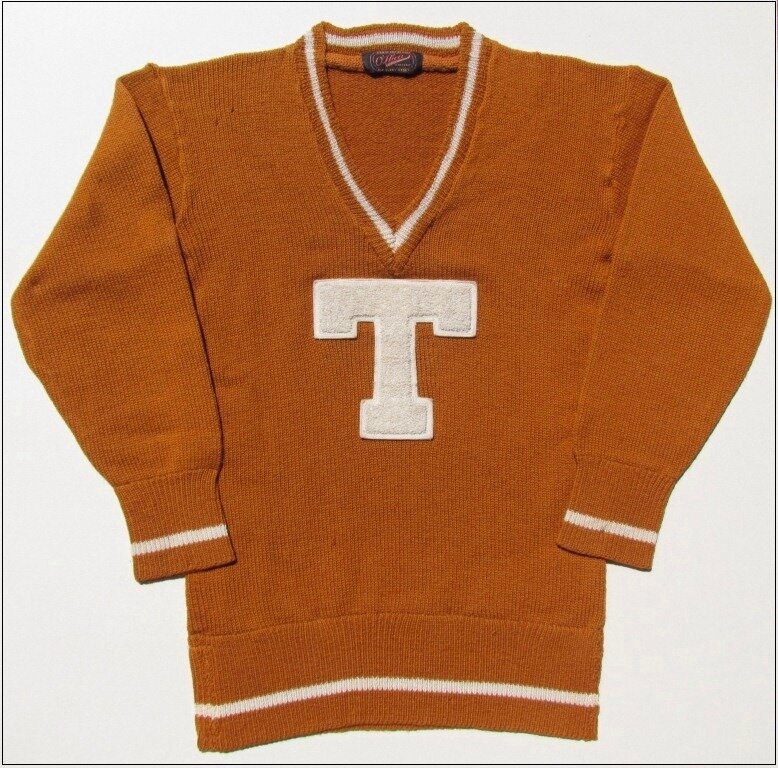The Road to Burnt Orange
While all Dorothy had to do was follow the yellow brick road, finding the Longhorn burnt orange road was as elusive as finding a pot of gold somewhere over the rainbow . It has been said that "what starts here (Texas) changes the world." If that is so, struggling to find that one exclusive color that captured the essence and spirt of the University of Texas is responsible for creating the universe’s color palette .
A substantial part of the article below is discussed in detail in this link from Alcalde. http://alcalde.texasexes.org/2011/08/longhorn-logo-turns-50/attachment/1919/
Below in the blue font are paraphrased comments and quotes from Jim Nicar. His video is also included.
There is a passionate long and surprisingly rich history of searching for the "right" color. A history of football coaches, baseball games, and world wars impacting the color agent "orange".
For a period of time after U.T. became an educational institution there was no collective "Varsity" mindset for the team colors. "Like a light wave bouncing off a eye, the history of UT's color isn't a straight line to today's burnt orange. It's oscillating—and at almost every turn contentious—a wave of varying shades.” The road from colors chosen at dusty general stores to a precise legally protect color was a tedious process.
The 70-year struggle for the "right" color scheme is full of Longhorn infighting, regime changes, and quarrels between UT leaders, students, and alumni convinced their color scheme is the best. It has been shaped by regents, students, alumni, and braggadocious ballplayers. Burnt orange was inspired by the emotions of fandom, personal and group identity ,
Baseball, not football, was the sport of choice for UT students in the mid-1880s. In the spring of 1885, when the University was not yet two years old, a student enrolled who claimed to have the only curveball pitch in the state. The curveball was a new addition to the game, welcomed by baseball progressives, and hated by the sport's purists. Nevertheless, University students formed a team "that rated high in brainpower, low in brute force," and challenged any college in Texas to a game. Thirty miles north in Georgetown, Southwestern University answered the call and invited UT to a picnic and baseball contest. The University accepted, and students arranged to make the trip to Georgetown on a chartered train.
On a Saturday morning in April 1885, the first UT baseball team and most the student body arrived at the downtown Austin train station at 3rd Street and Congress Avenue. They boarded the passenger cars bound for Georgetown. Everything was on schedule until the final whistle sounded. Then, just as the train was ready to leave, two coeds announced the need for some ribbon to identify them as University of Texas supporters.
Today's college fans arrive at stadiums clad in t-shirts and caps. But in the 1880s, colored ribbons were worn on lapels to show team loyalty. The more enterprising male students sported longer ribbons, so they would have extra to share with a pretty girl who had none. The truly ingenious (or just plain desperate) wore ribbons almost down to their knees.
The dates of the two Texas coeds, Venable Proctor and Clarence Miller, ever eager to impress the ladies, jumped off the train and sprinted a block north along Congress Avenue to the nearest general store. They managed to ask the shopkeeper for three bolts of two colors of ribbon between gasps for breath. "What colors?" the shopkeeper asked. "Anything," was the response. After all, the train was leaving the station, and there was no time to be particular.
The shopkeeper gave them the colors he had the most in stock: white ribbon, which was popular for weddings and parties and was always in demand, and bright orange ribbon because no one bought the color, and the store had plenty to spare.
Loaded with their supplies, Proctor and Miller ran back and boarded the moving train as it left for Georgetown. Along the way, the ribbon was evenly divided and distributed to everyone except for a law student named Yancey Lewis, "who had evolved a barbaric scheme of individual adornment by utilizing the remnants."
Unfortunately, it rained that Saturday afternoon, the curveball curved not, and Texas outfielders ran weary miles in a lost cause. According to one witness, the University's colors were "christened on a dire and stricken field."
Or were they? Even though the first baseball team had sported orange and white, the colors were by no means official and subject to the whims of future UT students.
The University team, though, didn't wear orange. Instead, their striped uniforms were gold and white.
1885
Orange and white made its first appearance in 1885 at UT's inaugural baseball game against Southwestern University. Then, after fifteen years of trying out other colors – from gold and white, to orange and maroon, to royal blue – the Board of Regents officially declared orange and white as UT's colors after a vote of students, faculty, staff, and alumni in 1900.
1893
In 1893 Students wanted the colors Maroon and Orange for the team colors. Still, since the word maroon was associated with a foul smell, the students chose gold and white uniforms because the colors represented the colors of the UT building architecture.
Gold and White - In 1893, UT Students identified themselves with their surroundings on the campus, and several University teams donned gold and white uniforms. However, gold and white were never the UT official colors and only lasted a short period.
After a decade of starts and stops, the University of Texas fielded its first "permanent" football team in 1893. The first recorded game was actually ten years earlier, during UT's very first fall term, though it was a rather embarrassing two-goals-to-none loss against a group of high school students at the Bickler School in downtown Austin. Football, the newfangled sport that could draw 50,000 spectators to a Princeton-Yale game in the 1880s, required a little more time to be accepted in the Lone Star State.
The UT football team of 1893 played four games, a pair in the fall and two more in the spring. The first was against the Dallas Foot Ball Club that claimed to be the best in the state. Held at the Dallas Fair Grounds, the game attracted a record 1200 onlookers. It was a challenging and spirited match, but the "University Eleven" had pulled off an 18 - 16 upset when the dust had settled. "Our name is pants, and our glory has departed," growled the Dallas Daily News. Nevertheless, the UT club would go on to a spotless record and earn the undisputed boast of "best in Texas."
1894
1894 Gold and White, Of course, was not official and only lasted a short period. Members of the student-run UT Athletic Association wanted a more "masculine" color, and in 1895 orange was paired with white.
1895
By 1895, the student-run UT Athletic Association wanted a more masculine color, and orange was paired with white. Unfortunately, white uniforms were difficult to clean after a hard-fought victory, so in 1897, to save cleaning costs, the Athletic Association opted for a maroon color that wouldn't show dirt as quickly.
For the next ensuing years, UT football, baseball, and track uniforms, along with letter sweaters, were orange and maroon.
Members of the student-run UT Athletic Association wanted a more "masculine" color, and in 1895 orange was paired with white once more. White uniforms, though, were difficult to clean after a hard-fought victory on the football field.
1898
Colors were orange and maroon to save on cleaning cost.
1899
1899 6 - 2 - Coach M.G. Clarke
Colors are gold and maroon.
This color change created more than a little controversy among the alumni. Adding to the confusion was the Cactus Yearbook, at the time published by the Athletic Association, listed the University colors as either gold or orange and white.
In 1899 a UT fan would have found his compatriots sporting all shades of yellows, oranges, whites, reds, maroons, and blue. Adding to the confusion was the Cactus Yearbook, published by the Athletic Association, which listed the University colors as either gold or orange and white. Unfortunately, the appearance of the 1899 Cactus made matters worse. It suddenly declared the University colors to be "Gold and Maroon," which just happened to be the exact hues used for the yearbook's cover. And all the while, students at the University's medical branch in Galveston wanted to throw out the double colors in favor of a single one: royal blue. There is no question that the University of Texas student body was a neurotic mess in 1899 fighting over a rainbow of colors, including shades of yellows, oranges, whites, reds, maroons, and a few in royal blue. The neurosis was so bad that the following year (1900), the Board of Regents decided to hold an election to settle the official UT colors.
1900 6-0- Coach S.H. Thompson
The colors are now "official," and the student body and administration vote for orange and white.
After considerable discussion, the Board of Regents decided to hold an election to settle the matter. Students, faculty, staff, and alumni were all invited to send in their ballots. Out of the 1,111 votes cast, 562 were for orange and white, a majority by just seven votes. Orange and maroon receive 310 votes, royal blue 203, crimson 10, royal blue, and crimson 11 votes, and there were a few other colors scattered among the remaining 15 votes.
Cactus Image of the U.T. colors in the 1900's
We don’t know precisely why orange and white won out in the 1900 poll, or why it stayed so popular in the tenuous early days of UT athletics. But we know a bit about how Color works and what it means to people. It’s a matter of both personal taste and group identity, in addition to science. “Color is really a vibration. It’s energy,” says Gillian Rose, a New York-based color scientist and consultant. “It is not cognitive; it’s a physical, biological reaction.” In the lower middle portion of our brains, our hypothalamus processes Color along with other sensory inputs. It translates those senses into emotions and even physical states, like thirst or hunger.
1910 - brighter orange
Therefore, humans have innate reactions to specific colors, ancestral memories that tell us that, for example, black and yellow—the easiest color contrast to see—means danger. Rose claims that extroverted people like vibrant colors, searching for external stimulation, while introverted people seek calm, cool colors. But socially, we’re programmed with other associations. Think color-coded gender reveals for expecting parents, or red-and-blue maps in the news. These meanings are constructed but powerful.
1925
Unfortunately, the bright orange dye faded when washed and turned yellow which resulted in the Longhorn opponents calling the Longhorns "yellow bellies".
Copy of The Daily Texan from 1925 in the U.T. Archives, The article read:
"When crowds watch the Longhorns fight their way through one of the stiffest schedules of their career, the men will wear uniforms of a color slightly different from the proverbial orange and white, according to S. N. Eckdahl of the University athletic staff, who has been issuing equipment to the Longhorn players."
U.T. teams wore orange and white for a quarter-century, but other schools were also claiming the color scheme. Tennessee adopted its orange and white in 1889, though the team didn't wear orange jerseys until 1922. The U.T. athletics department decided to make a change to help the Longhorns stand out among the herd—"an orange and white, which should be Texas' own."
"As a consequence," the paper stated, "a combination of dyes was used to produce a shade different from the standard Orange.
The new shade is darker, being more of burnt orange." The color change, according to research by UT historian Jim Nicar, is credited to Coach E. J. "Doc" Stewart. When Clyde Littlefield took charge in 1927, he worked with O'Shea Knitting Mills of Chicago to perfect the dyes needed to ensure that Horns stayed suitably dark Orange.
Littlefield recalled that O'Shea told him: "When you get the color of orange you like, we're gonna establish it as your orange." Longtime Texas sports information director Bill Little, BJ '65, Life Member, points out that "the color that Mr. Littlefield helped create back in 1928 is officially named Texas Orange."
Burnt Orange is a medium-dark orange that evokes visions of flames. "When we look at orange, we're looking at how much yellow versus red is in there," she says. Ours is a patinated orange—browner, darker, and calmer. Rose, looking at a swatch of Texas orange, reads it like a tarot card. Burnt Orange represents aggression. Enthusiasm. Rejuvenation. It's a competitive color. "Courage is a big one. "Over-confident," she laughs. "That's good for a team, right?"
1928- Coach Clyde Littlefield
Littlefield makes the official color change to “Texas Orange”. Burnt Orange is used until WWII causes shortages in the dyes needed to make "burnt orange."
But during World War II, when everything from chocolate to typewriters was rationed, Texas Orange dyes went off the market—they had been produced for O'Shea in Germany. The Horns switched back to a lighter hue, another yellowy-orange that the regents made official on U.T.'s seal in 1950.
1962
In the early 1960s, Coach Royal changes the color of the Texas uniforms from bright orange to the Clyde Littlefield era Burnt Orange. Many in the fan base were not happy.
In 1966 72 students and alumni disagreed with Royal and asked the Board of Regents to eliminate the "dark, muddy, and murky burnt orange" that DKR supported. A color inspired by Clyde Littlefield before WWII. Supported this decision to revert to the burnt orange (Texas Orange) used before WWII. The lighter orange antagonist signed a petition to reinstate the "true regental style," convening a faculty committee to create a report.
After sampling swatches and piecing together a timeline, a serious and somber color committee chose burnt orange as the selected color. "Texas Orange," named during the Clyde Littlefield days, became the official color of U.T.
The report included this rather somber, Atlas-like note of grave responsibility: "The committee's approach to the issue was one of serious intent, recognizing the forces of traditional continuities and symbolism which are associated with patriotic emotion and which are invaluable in giving both identity and unifying spirit to a university," wrote committee chairman and U.T. Vice Chancellor for Public Affairs Raymond Vowell.
"It is without question that tradition and common usage have shown a decided general preference for the darker hue or burnt orange," Vowell continued. "The burnt orange is nationally identified as the official color of The University of Texas and is described elsewhere as 'Texas Orange.'" The regents here made an interesting choice that foreshadows the contemporary legal protection of the color. It's an important distinction, as burnt orange is a general term, but using the shade along with, say, the word "Texas" might today be seen by U.T. as an infringement on the school's identity.
Pantone 159- Perhaps the deep association with the color may have something to do with the fact that Royal’s and Brown’s squads won all 4 national championships wearing Pantone 159.
The traditionalists lost the battle, and burnt orange enthusiasts ruled the Longhorn nation. Burnt orange became the "Texas-y" color and was legally protected by the U.T. Brand, Trademarks, and Licensing office.
Once Royal had the Horns in burnt orange, he was asked if he’d ever change the uniforms again—to add ornamentation, to liven up the design. But lively was not his aim.
“Hell, no,” Royal famously responded. “I’m not going to candy this thing up. These are work clothes.”
Texas's use of lighter orange was also mostly confined to the era of black-and-white photography, making it harder for those early shades to stick or even appear in memory. And while many can still remember Royal's reign, few, if any, can recall the days of Doc Stewart. Royal's burnt orange signifies a less flashy, more earthy aesthetic, one that resonates today with Texas fans' generations. Not only has burnt orange been a tradition, off and on, for nearly a century, but the color itself seems rooted in history—a dignified shade of orange.
It was 1967 when burnt orange became official.
It’s hard to imagine burnt orange ever giving way. Even Chairman Frank Erwin got involved in the “true” Longhorn color. He said, “I suggest that we adopt the standard orange that’s the color on the arch at the student union. It is not light orange; it’s burnt orange or dark orange. I know because I went by yesterday to see it. At this point, it is enshrined by the regents as the official shade. It is legally protected, so don’t go attempting to use Pantone 159 for your business. It has, in the last 50 years, become a classic. And isn’t there something, for lack of a better word, Texas-y about burnt orange?
It is the color of red dirt, the color of a steer’s hide. “The burnt-orange color is truly unique and distinctive and is one of the biggest differentiators for our brand when compared to other institutions in this country and across the world,” according to UT’s Brand, Trademarks, and Licensing office. Not only is the shade legally protected, but it’s carefully crafted to ensure that in person and on TV, the Longhorns look like they’re wearing the correct hue.
Using the latest technology to pinpoint burnt orange shade resembles the original intention for the color and what our fans expect. The legal protections aren’t just in place to ensure that burnt orange is used correctly in official capacities and isn’t used in any unofficial way. In 2009, an Austin-based agency called Mutual Mobile created UT Directory, a mobile-friendly version of UT’s staff and student directory. The university objected to the company’s use of burnt orange; however, maintaining that the use of the color and UT in the name could lead people to believe it was an official UT product. The company did away with the color scheme.
With all that work and tradition baked into the color, it’s now an integral part of UT’s identity. And it seems unlikely to change as capriciously as it did in the past. “If you stick with the same design for decades, as the Longhorns have done, then you become de facto classic. Simple design, great design. It ain’t broke, and they haven’t fixed it,” says Paul Lukas, a blogger for ESPN and founder of UniWatch, a website dedicated to analyzing sports uniforms. “Hope it stays that way.


